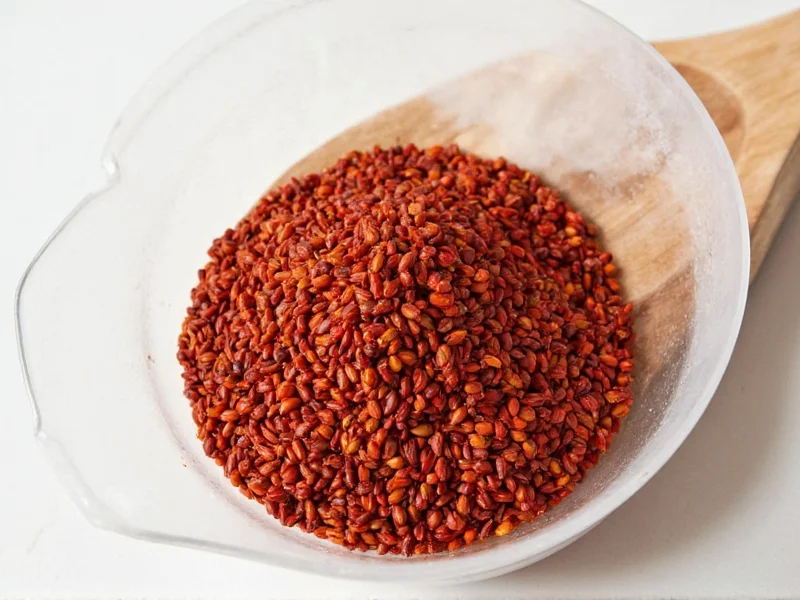Achiote seeds, also known as annatto seeds, have been used for centuries across tropical regions for both culinary and traditional purposes. These small, reddish seeds from the Bixa orellana plant deliver a distinctive orange hue and mild, earthy flavor that forms the foundation of many traditional dishes throughout Latin America, the Caribbean, and parts of Asia.
Understanding Achiote Seeds Properties
Before learning how to use achiote seeds, it's important to understand their key characteristics. Unlike many spices, achiote primarily contributes color with only subtle flavor notes—earthy, slightly peppery, and reminiscent of nutmeg or cloves. The seeds contain bixin, the compound responsible for their vibrant color, which is fat-soluble. This explains why oil-based extraction methods yield the most intense color.
| Extraction Method | Best For | Color Intensity | Flavor Profile |
|---|---|---|---|
| Achiote Oil | Frying, marinades, sautéing | ★★★★★ | Mild, earthy |
| Achiote Paste | Mojo, recados, seasoning blends | ★★★★☆ | Robust, complex |
| Achiote Water | Rice, soups, stews | ★★★☆☆ | Subtle, delicate |
| Whole Seeds | Infusions, slow-cooked dishes | ★★☆☆☆ | Very mild |
Step-by-Step Achiote Preparation Methods
Making Achiote Oil at Home
Creating achiote oil represents one of the most effective ways to use annatto seeds in cooking. Start by heating 1 cup of neutral oil (like canola or vegetable oil) over low heat. Add 2-3 tablespoons of achiote seeds and gently warm for 5-7 minutes until the oil turns deep orange. Do not let the oil smoke or the seeds burn, as this creates bitterness. Remove from heat, cool slightly, then strain through cheesecloth. Store your achiote oil in a dark glass bottle away from light for up to one month. This vibrant oil works perfectly for frying plantains, seasoning beans, or as a base for marinades.
Traditional Achiote Paste Recipe
For authentic Latin American dishes requiring how to prepare achiote water alternatives, the traditional paste delivers concentrated flavor and color. Combine 3 tablespoons achiote seeds, 4 peeled garlic cloves, 1 teaspoon each of dried oregano and cumin, 1 teaspoon salt, and 1/4 cup white vinegar in a blender. Process until smooth, adding small amounts of water only if necessary to achieve a thick paste consistency. This versatile achiote seasoning technique forms the base for recado rojo used in Yucatecan cuisine and works beautifully as a meat rub before grilling or roasting.
Preparing Achiote Water for Rice and Soups
When you need a lighter color application, how to use achiote seeds for coloring food without overwhelming oil content becomes essential. Simmer 2 tablespoons achiote seeds in 1 cup of water for 15 minutes over low heat. Strain the liquid through a fine mesh sieve, pressing the seeds to extract maximum color. Use this vibrant liquid to replace regular water when cooking rice, creating beautifully colored arroz con pollo or adding subtle color to soups and stews. The resulting dish will have that characteristic golden-orange hue without added fat.
Culinary Applications and Recipe Ideas
Achiote seeds shine in numerous traditional preparations across different cultures. In Puerto Rican cooking, use achiote oil to prepare sofrito as the flavor base for stews and beans. For authentic Mexican cochinita pibil, combine achiote paste with bitter orange juice and spices to marinate pork before slow-roasting. Filipino atchara (pickled papaya) sometimes incorporates achiote for color, while Venezuelan hallacas use achiote-infused dough.
When exploring achiote seeds culinary applications, remember they work best with ingredients that allow their color to shine—rice, cheese, sauces, and light-colored proteins like chicken or fish. Avoid using achiote with strongly colored ingredients like tomatoes that will mask its vibrant hue.
Storage Recommendations and Substitution Options
Proper storage ensures your achiote seeds maintain their coloring power. Keep whole seeds in an airtight container away from light and heat for up to one year. Prepared achiote oil or paste should be refrigerated and used within one month for best results. If your seeds lose their vibrant red color, they've likely lost potency and should be replaced.
When you need achiote seeds substitute options, consider these alternatives based on whether you prioritize color or flavor. For color only, use a pinch of turmeric (use sparingly as it has strong flavor) or paprika. For flavor with less intense color, try a combination of sweet paprika and a touch of saffron. Note that no substitute perfectly replicates both the distinctive color and mild flavor of authentic achiote.
Common Mistakes to Avoid
Many home cooks make critical errors when learning how to use achiote seeds properly. Never use excessive heat when preparing achiote oil, as this burns the delicate seeds and creates bitterness. Avoid using too many seeds, which can make dishes overly dark without adding significant flavor. Don't skip the straining step—whole seeds left in your preparation create unpleasant texture. Finally, don't expect achiote to provide strong flavor; its primary role is coloring with only subtle flavor enhancement.
Expanding Your Achiote Knowledge
As you become more comfortable with basic achiote seed preparation methods, experiment with regional variations. Try adding orange zest to your achiote paste for authentic Yucatecan flavor, or incorporate achiote oil into mayonnaise for vibrant sandwiches. Some chefs toast achiote seeds lightly before grinding to enhance their earthy notes, though this technique requires careful temperature control to avoid bitterness.











 浙公网安备
33010002000092号
浙公网安备
33010002000092号 浙B2-20120091-4
浙B2-20120091-4